TheAre you looking for a memorable experience in Hanoi, Vietnam? Then, you should definitely try the Hanoi city tour with Vietnam Bat Trang Ceramics Village. This tour will not only let you explore the rich culture and history of Hanoi but also give you a chance to witness the traditional pottery making process at Vietnam Bat Trang Ceramics Village. In this article, we will discuss everything you need to know about this tour and why it should be on your must-do list in Hanoi.
Overview of Hanoi City Tour with Vietnam Bat Trang Ceramics Village
The Hanoi City Tour with Vietnam Bat Trang Ceramics Village is a full-day tour that offers visitors a chance to explore the rich culture and history of Hanoi. With visits to iconic landmarks like the One Pillar Pagoda and Ho Chi Minh Mausoleum, visitors can learn about Vietnam’s spiritual and intellectual traditions and the life and legacy of Ho Chi Minh. The tour also includes a visit to the vibrant and bustling Old Quarter, where visitors can experience the local culture and sample delicious street food. With a flexible cancellation policy and affordable pricing, this tour is an excellent way to experience the best of Hanoi.
Tour Schedule
The Hanoi city tour with Vietnam Bat Trang Ceramics Village is available seven days a week, with a set itinerary and schedule for visitors to follow.
The tour begins with a hotel pick-up in the Old Quarter at 7:45 am, followed by a visit to Tran Quoc Pagoda, one of the oldest and most significant pagodas in Hanoi. Visitors then proceed to Ho Chi Minh’s Mausoleum, where they can pay their respects to the late leader and learn about his legacy. The tour also includes a visit to Uncle Ho’s Stilt House, where Ho Chi Minh lived and worked from 1958 to 1969.
Next, visitors will explore the One Pillar Pagoda, a symbol of Hanoi modeled after a lotus flower, before heading to the traditional ceramics village of Bat Trang. Here, visitors can visit showrooms and learn about the history and art of ceramics. Alternatively, the tour may visit the Vietnam Museum of Ethnography instead, depending on the day of the tour.
Afterwards, visitors will have lunch at a local restaurant in the Hanoi Old Quarter before continuing on to the Temple of Literature, the first university in Vietnam constructed in 1070. The tour concludes with a visit to Hoan Kiem Lake and Ngoc Son Temple, dedicated to General Commander Tran Hung Dao, before being dropped off back at their hotel at 4:00 pm.
Visitors should note that tours on Tuesday, Thursday, Saturday, and Sunday will visit the Vietnam Museum of Ethnography, while tours on Monday, Wednesday, or Friday will visit the traditional ceramics village of Bat Trang.
Eligibility
Children aged 0-4 are welcome to join the Hanoi city tour with Vietnam Bat Trang Ceramics Village free of charge. Children aged 10 and above will be charged the same rate as adults. For families with two adults, one child aged 0-5 can join the tour for free. If there are more than one child aged 0-5 in the group, the additional child will require a child ticket to join the tour.
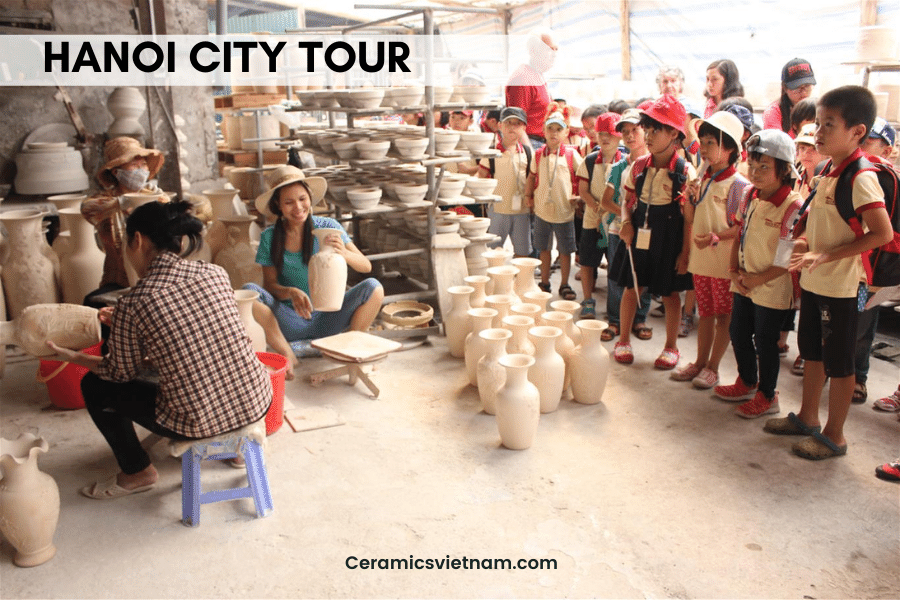
The Hanoi city tour with Vietnam Bat Trang Ceramics Village offers affordable pricing for adults and children
Listed price for the tour
The Hanoi city tour with Vietnam Bat Trang Ceramics Village offers affordable pricing for adults and children, making it an accessible and enjoyable experience for all.
The adult pricing for the tour is currently listed at US$26.19, with a minimum requirement for booking. Visitors can enjoy a comprehensive and informative experience of Hanoi’s most sought-after attractions at an affordable price. For children between the ages of 5 and 9, the tour offers a discounted price of US$19.65. This provides an excellent opportunity for families to experience the city together and make lasting memories.
The price includes admission to all attractions on the tour that allows visitors to explore and learn about Hanoi’s most significant landmarks without having to worry about purchasing tickets separately. The tour also includes an English or Vietnamese-speaking guide who is knowledgeable about the history and culture of Hanoi. The guide provides detailed information about each attraction and offers insights into the local way of life. Lunch is also included in the tour package, providing visitors with the opportunity to sample some of the local cuisine and experience the unique flavors of Hanoi. Round-trip transfers to and from your hotel are also included, providing convenience and ease of transportation for visitors.
It’s important to note that the tour does not include other personal expenses, such as souvenirs or additional food and drink purchases. Tips and gratuities for the guide and driver are also not included and are at the discretion of the visitors. Insurance is also not included in the tour package, so visitors should make sure to obtain travel insurance before embarking on the tour to ensure adequate coverage for any unforeseen circumstances.
Prommotion
The tour also offers several options for visitors to save money and get the best value for their tour experience.
- Visitors can take advantage of a 5% discount on selected packages. This discount is available until 11:59 pm on December 31, 2023, and provides an excellent opportunity for visitors to save money on their tour.
- The tour also offers a best price guarantee, ensuring that visitors get the best price for the activity. If visitors find a cheaper price for the tour elsewhere, the tour provider will match the difference (terms and conditions apply).
- Additionally, visitors can earn Klook credits by booking the tour, with 0.6% free credit available on this activity. These credits can be used towards future bookings, providing added value and savings for visitors.
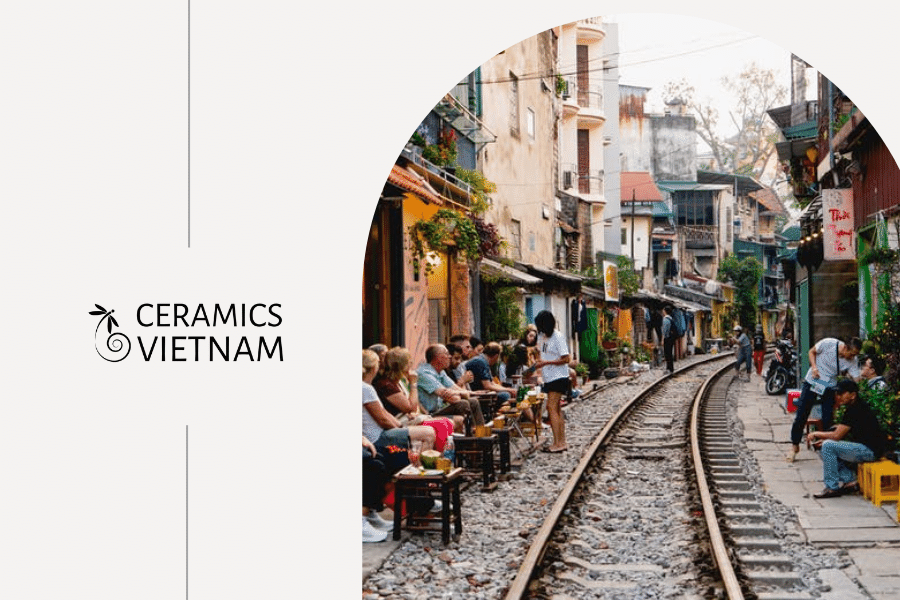
The tour also offers several options for visitors to save money
Surcharge Table
When booking the Hanoi city tour with Vietnam Bat Trang Ceramics Village, visitors should take note of the holiday surcharge of VND 100,000 per person. This surcharge applies on holidays and must be paid in cash directly to the driver. Visitors should plan their itinerary accordingly and budget for this additional charge to avoid any unexpected expenses.
Confirmation and Cancellation Policy
Visitors who book the Hanoi city tour with Vietnam Bat Trang Ceramics Village can expect prompt confirmation of their booking. In the rare event that confirmation is not received, visitors can contact customer support for assistance.
The tour has a flexible cancellation policy, offering a full refund to visitors who cancel at least 24 hours before the activity starts. In the event of unforeseen circumstances or extreme weather, the operator reserves the right to cancel the tour. If this happens, visitors will have the option to reschedule the tour or request a full refund. This ensures that visitors can book their tour with confidence, knowing that their investment is protected.
Meet Up Information
To avoid missing the Hanoi city tour with Vietnam Bat Trang Ceramics Village, visitors are advised to arrive at the designated meet-up location 15 minutes before the scheduled activity time. Latecomers or no-shows will not be eligible for a refund.
For those staying outside of Hanoi Old Quarter, there are two alternate meet-up points available, with the meet-up time set for 8:20 am. The address for the alternate location is Hanoi Opera House, 1 Trang Tien Street, Hoan Kiem District, Hanoi, and visitors can refer to the tour’s website for further assistance.
To reach the meet-up location, visitors are encouraged to take a taxi or car, and to allow for sufficient travel time to arrive on time. Proper planning can ensure a smooth and enjoyable start to the Hanoi city tour with Vietnam Bat Trang Ceramics Village.
Additional information
- Visitors have the option to cycle around the Old Quarter for an additional fee of VND 100,000 per person. This fee is payable directly to the tour guide and provides visitors with a unique and active way to explore the area.
- The tour is equipped to accommodate special dietary requirements such as allergies, gluten intolerance, vegetarian diets, and other dietary needs. Visitors can feel assured that their dietary needs will be met during the tour.
- The Hanoi city tour with Vietnam Bat Trang Ceramics Village is accessible for visitors using strollers or wheelchairs. This ensures that visitors of all abilities can enjoy the tour and have a comfortable and enjoyable experience.
- Visitors must use their voucher at the date and time they selected when booking the tour. The voucher is valid for use only during the selected time and date.
- Visitors present their mobile voucher at the start of the tour. This ensures a smooth check-in process and allows visitors to begin their tour as quickly and efficiently as possible.
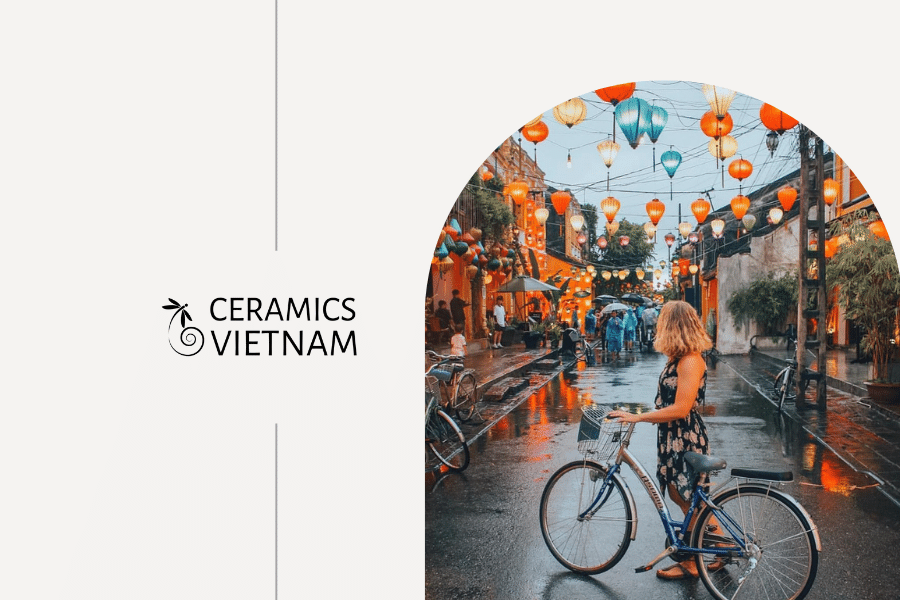
The city tour has proper planning in time and places to visit
Why You Should Take Hanoi City Tour with Vietnam Bat Trang Ceramics Village
Take the tour with the professional guide
The Hanoi City Tour with Vietnam Bat Trang Ceramics Village offers visitors an immersive and informative introduction to the city’s most sought-after attractions. With a professional guide accompanying visitors, the tour takes them to some of the most iconic and historic landmarks in Hanoi, providing a comprehensive experience.
The presence of a professional guide on the tour offers several advantages. The guide possesses extensive knowledge about the history and culture of Hanoi and can provide visitors with detailed information about each attraction. This allows visitors to gain a deeper understanding of the significance of each landmark and have a more immersive experience.
Furthermore, the guide can also offer insights into the local culture and way of life. They can recommend local restaurants and street food vendors, provide tips on how to navigate the city like a local, and offer suggestions on off-the-beaten-path activities that may be of interest to visitors.
In addition to providing information and recommendations, having a guide on the tour also provides an added level of safety and security. They can help visitors avoid potential scams or unsafe situations, and provide assistance if needed, ensuring that visitors can fully enjoy their experience without any concerns.
In summary, the Hanoi City Tour with Vietnam Bat Trang Ceramics Village, with a professional guide, offers visitors a unique and memorable experience, immersing them in the rich history and culture of Hanoi while ensuring their safety and comfort.
Explore the Rich Culture and History of Hanoi
The tour will take you to some of the most famous and historic tourist attractions in Hanoi, giving you a chance to explore the rich culture and history of the city. You will learn about the life and legacy of Ho Chi Minh, one of Vietnam’s most influential leaders, at his mausoleum. You will also discover the country’s spiritual and intellectual traditions at the One Pillar Pagoda and the Temple of Literature, respectively.
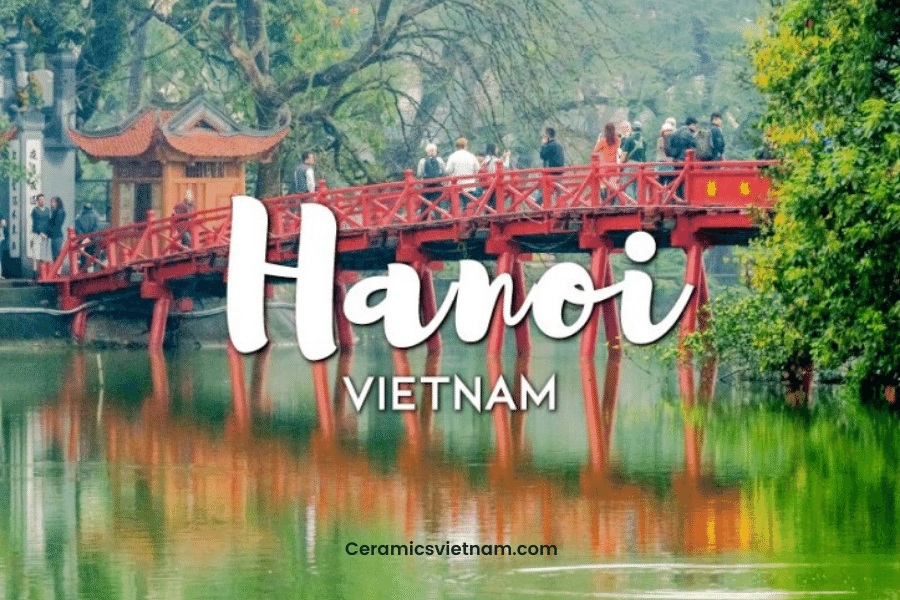
The journey is an excellent way to experience the best of Hanoi
Experience the Old Quarter
The Hanoi Old Quarter is a must-visit destination for anyone traveling to the city. It is home to numerous narrow streets and alleys, each with its unique character, where you can experience the hustle and bustle of local life. You can browse the colorful shops and street vendors, sample delicious street food, and interact with friendly locals. The Hanoi city tour with Vietnam Bat Trang Ceramics Village includes a visit to the Old Quarter, so you can experience this vibrant and exciting part of the city.
Witness Traditional Pottery Making
Vietnam Bat Trang Ceramics Village is renowned for its traditional pottery making techniques, which have been passed down through generations of local artisans. The village produces a wide range of ceramic products, from dishes and vases to figurines and lanterns, all crafted by hand. On the tour, you will get a chance to witness the process of making pottery and even try it yourself under the guidance of a local artisan.
Buy Souvenirs and Handmade Crafts
The tour will also take you to a local market where you can buy souvenirs and other handmade crafts made by local artisans. The market offers a wide range of products, from pottery and ceramics to clothing and jewelry. You can also interact with local vendors and learn about their craft and culture.
Highlights of Hanoi City Tour with Vietnam Bat Trang Ceramics Village
Here are some of the highlights of the Hanoi city tour with Vietnam Bat Trang Ceramics Village:
Ho Chi Minh Mausoleum
Ho Chi Minh Mausoleum is a famous historic landmark located in the heart of Hanoi, Vietnam. It is the final resting place of Ho Chi Minh. He is regarded as the father of modern Vietnam.
Ho Chi Minh was a revolutionary leader who played a crucial role in Vietnam’s struggle for independence from colonial powers. He served as the first President of the Democratic Republic of Vietnam from 1945 until his death in 1969. After his death, his body was embalmed and placed in a glass coffin for public viewing.
The mausoleum is a massive structure made of granite and marble, with a large red flag flying atop the roof. It was designed by a team of architects and engineers led by a Soviet architect named Ernst Mayr. The design of the mausoleum was inspired by the Lenin Mausoleum in Moscow, Russia.
The interior of the mausoleum is austere and solemn, with guards in traditional dress standing at attention. Visitors can not take photos or speak inside the mausoleum. Your silent shows respect to him
The mausoleum is open to the public, and visitors from all over the world come to pay their respects to Ho Chi Minh and learn about his life and legacy. The mausoleum is one of the most popular tourist attractions in Hanoi, and it is especially crowded during peak season.
Visitors are required to dress respectfully when visiting the mausoleum, with shoulders and knees covered. Bags and cameras are not allowed inside, and visitors are asked to deposit them at a secure area before entering. The mausoleum is open daily from 7:30 am to 10:30 am, except on Mondays and Fridays when it is closed.
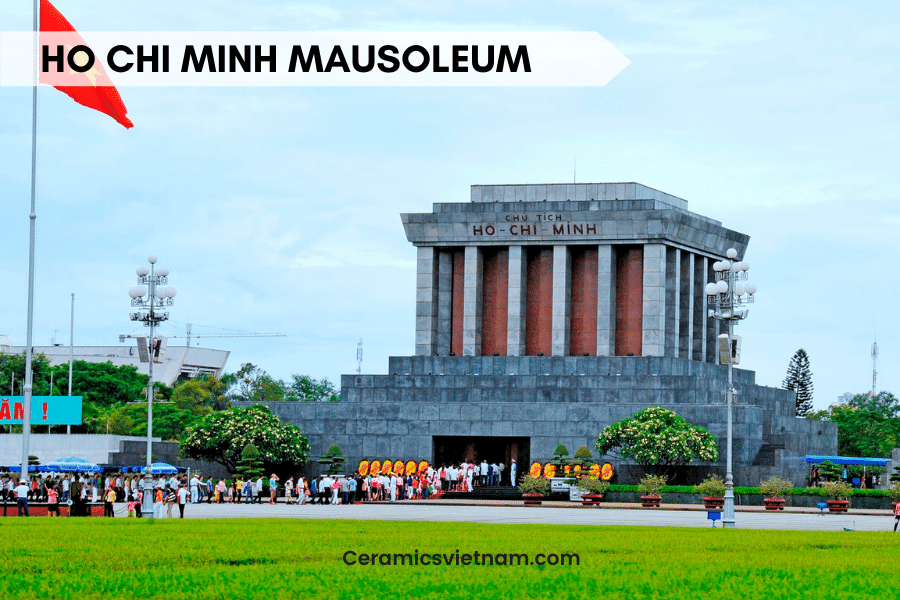
The Ho Chi Minh Mausoleum is a famous historic landmark located in the heart of Hanoi
One Pillar Pagoda
The One Pillar Pagoda is a historic Buddhist temple located in the heart of Hanoi, Vietnam. It is considered one of the most iconic and unique structures in the city, and a must-visit destination for anyone traveling to Hanoi.
The pagoda was first constructed in 1049 by Emperor Ly Thai Tong, who ruled from 1028 to 1054. According to legend, the emperor had a dream where he met the Goddess of Mercy, who handed him a baby son while seated on a lotus flower. The emperor interpreted this dream as a sign of divine favor and commissioned the construction of the pagoda in gratitude.
The pagoda is built on a single pillar that is just over four meters tall, and it is surrounded by a lotus pond. The structure was designed to resemble a lotus flower rising out of the water, which is a symbol of purity and enlightenment in Buddhist culture. The pagoda is made of wood, and the exterior is painted in a vibrant red color with gold accents.
Inside the pagoda, there is a small shrine dedicated to the Goddess of Mercy, which is decorated with beautiful sculptures and carvings. The atmosphere inside the pagoda is peaceful and serene, and visitors are often struck by its beauty and simplicity.
Over the centuries, the One Pillar Pagoda has been destroyed and rebuilt several times due to war and natural disasters. The current structure is a reconstruction from 1955, built on the original foundation. Despite its turbulent history, the pagoda remains a testament to Vietnam’s rich cultural heritage and the enduring power of Buddhist traditions.
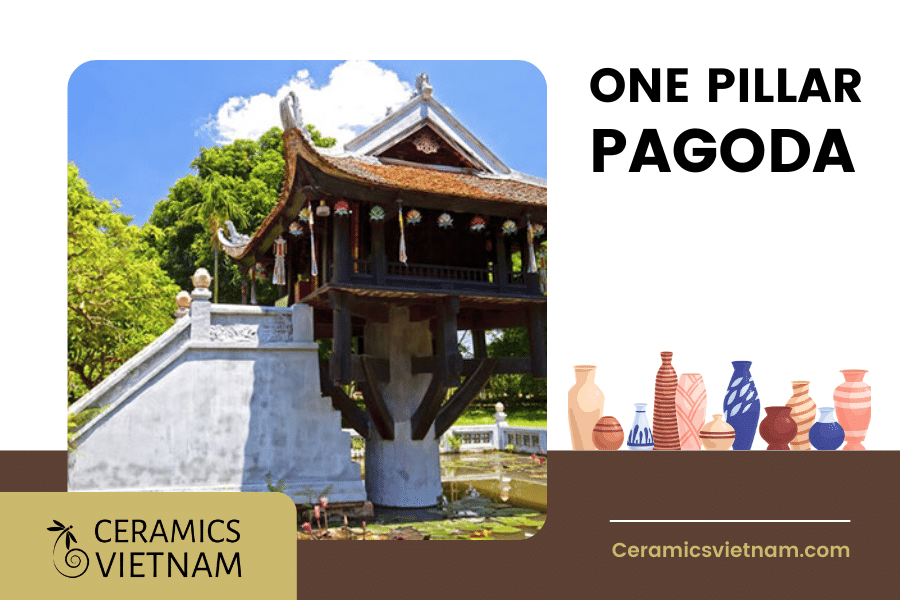
The One Pillar Pagoda is a historic Buddhist temple
Hoan Kiem Lake
Hoan Kiem Lake is one of the most popular tourist attractions in Hanoi, and for good reason. This beautiful lake is located in the heart of the city, in the Hoan Kiem district, and it is surrounded by lush greenery and ancient temples and pagodas.
One of the most striking features of the lake is the red-painted The Huc Bridge, which connects the shore to the small island in the middle of the lake where Ngoc Son Temple is located. This temple is a popular destination for visitors and offers stunning views of the lake from its balconies.
Hoan Kiem Lake is also home to several species of turtles, including the rare and endangered giant softshell turtle, which is considered a symbol of longevity and good luck in Vietnamese culture. Visitors can spot these turtles swimming in the lake or sunbathing on the rocks near the shore.
The lake is a popular spot for locals and tourists alike, with many visitors enjoying a leisurely stroll along the lake’s promenade or taking a seat on one of the many benches to relax and take in the view. In the early morning hours, locals can be seen practicing tai chi or jogging around the lake, while in the evening, the area comes alive with street performers and vendors selling snacks and souvenirs.
Hoan Kiem Lake is a must-visit destination for anyone traveling to Hanoi. It offers a peaceful retreat from the busy city streets and a glimpse into the rich cultural heritage of Vietnam. Whether you are interested in history, nature, or just want to soak up the atmosphere of this vibrant city, Hoan Kiem Lake is a must-see attraction that should not be missed.
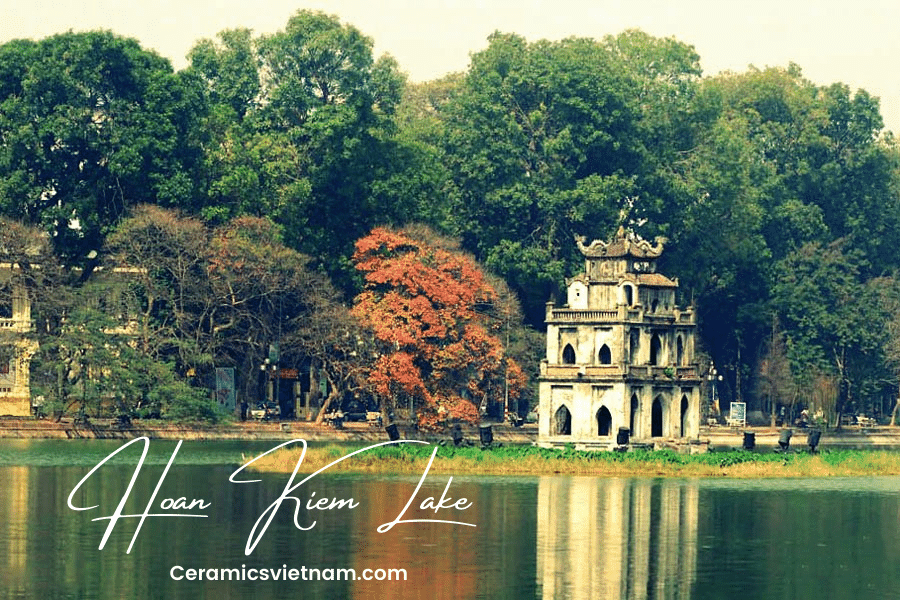
Hoan Kiem Lake is a must-visit destination for anyone traveling to Hanoi
Temple of Literature
The Temple of Literature is a significant historical landmark located in the Ba Dinh district of Hanoi. The temple is a dedication to the Chinese philosopher and educator, Confucius and dates back to the 11th century. Originally built as a center of learning, the temple houses Vietnam’s first university, which was established in 1076 to educate the country’s elite scholars.
Visitors to the Temple of Literature can explore several courtyards, gardens, and pavilions, each with unique features and attractions. The complex also includes the Well of Heavenly Clarity, a popular feature that is said to be the source of the temple’s spiritual energy. The beautiful gardens and courtyards are filled with ancient trees, statues, and shrines that make for a scenic and peaceful stroll.
One of the temple’s main attractions is the stelae of doctors, which are stone tablets inscribed with the names of scholars who passed the royal exams during the Ly and Tran dynasties. The stelae are a testament to the temple’s rich history and the importance of education in Vietnamese culture.
Visiting the Temple of Literature is a unique opportunity to learn more about Vietnamese culture and history. The serene and beautiful surroundings, coupled with the rich history of the temple, make it a must-visit destination in Hanoi.

The Temple of Literature is one of the most iconic and historic landmarks in Hanoi.
Hanoi Old Quarter
The Hanoi Old Quarter is one of the most dynamic and lively areas in the city, located in the Hoan Kiem district. This historic neighborhood is renowned for its narrow streets, ancient buildings, and bustling markets that offer a glimpse into traditional Hanoi life.
Dating back to the 13th century, the Old Quarter served as a hub of trade and commerce for centuries. Today, it is a popular destination for visitors who want to experience the rich cultural heritage of Hanoi.
The Old Quarter features several markets, including the famous Dong Xuan Market, which is one of the largest and oldest markets in the city. Visitors can find a wide range of goods such as souvenirs, clothing, fresh produce, and delicious street food at this vibrant market.
Exploring the Old Quarter on foot is one of the best ways to soak up the atmosphere of the neighborhood. Many of the streets are too narrow for cars or motorcycles, allowing visitors to meander through the winding alleys and streets, immersing themselves in the sights and sounds of traditional Hanoi life. Along the way, visitors can sample the famous street food sold on almost every corner, providing a unique culinary experience.
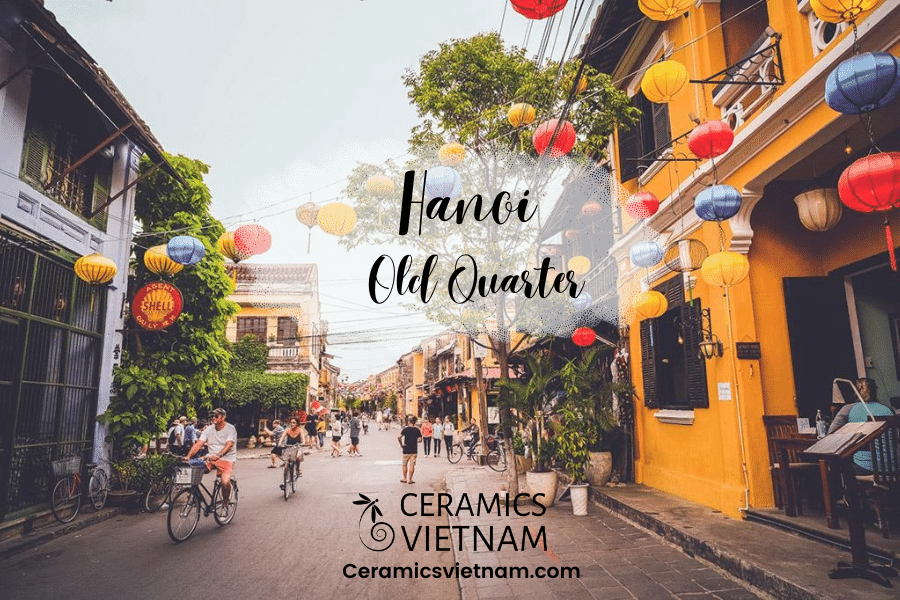
The Hanoi Old Quarter is one of the most vibrant and exciting areas in the city
Exploring Vietnam Bat Trang Ceramics Village
After exploring the bustling streets of Hanoi, it’s time to head out to Bat Trang and experience the beauty of Vietnamese ceramics.
History of Bat Trang
Bat Trang is a traditional ceramics village located just outside of Hanoi, and it has a rich and fascinating history that dates back over 1,000 years.
The village was first established in the 11th century, during the Ly Dynasty, and it quickly became a center of ceramic production in Vietnam. The villagers used the local clay from the Red River to make a wide variety of ceramics, including bowls, vases, plates, and figurines.
Over the centuries, Bat Trang continued to flourish, and it became famous throughout Vietnam and beyond for its beautiful and intricate ceramics. The village’s ceramics were used for both practical and decorative purposes, and they were often given as gifts to members of the royal family and other important figures.
In the 18th century, Bat Trang began to produce large quantities of ceramics for export, and it became a major player in the international ceramics market. The village’s ceramics were sold in markets across Asia, and they were particularly popular in Japan and China.
Despite the ups and downs of history, Bat Trang continued to produce ceramics for over 1,000 years, and today it is still one of the most famous and important ceramics villages in Vietnam. The village is home to hundreds of ceramics workshops and stores, and visitors can see the traditional methods of ceramic production that have been passed down from generation to generation.
Bat Trang ceramics are known for their intricate designs and vibrant colors, and they are still produced using traditional techniques, such as hand-painting and wood-fired kilns. Visitors to the village can watch the craftsmen at work, learn about the history of Bat Trang, and purchase beautiful ceramics to take home as souvenirs.
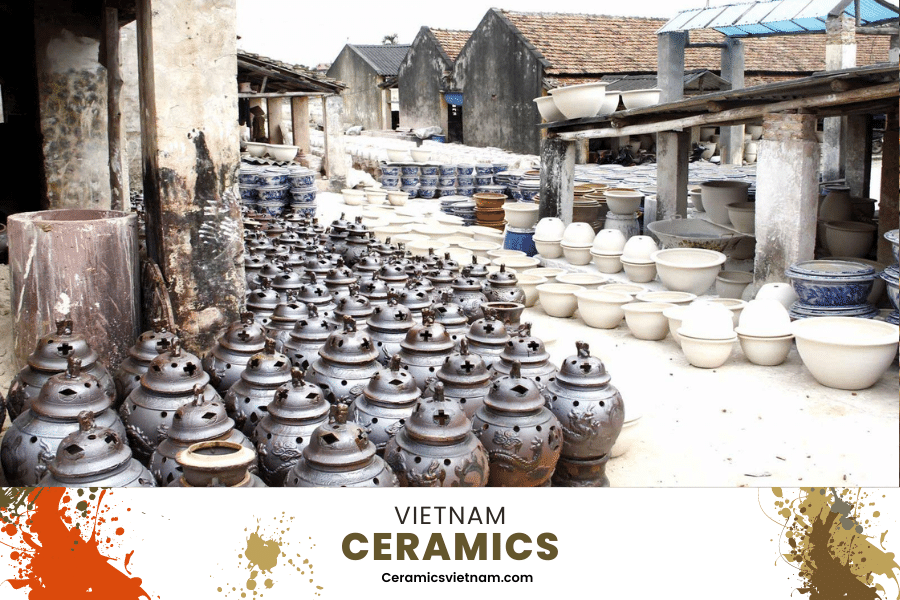
Bat Trang has continued to produce ceramics for over 1,000 years
Touring Bat Trang
Touring Bat Trang is a unique and unforgettable experience that offers a glimpse into the traditional ceramic-making process and the rich cultural heritage of Vietnam.
Visitors to Bat Trang can explore the village on foot, taking in the sights, sounds, and smells of the local workshops and stores. Many of the ceramics workshops in Bat Trang are open to visitors, and they offer guided tours that explain the different stages of the ceramic-making process, from shaping and molding to firing and glazing.
Visitors can watch the skilled craftsmen at work, using traditional techniques to create intricate designs and patterns on the ceramics. They can also try their hand at making their own ceramics, with many workshops offering classes and workshops for beginners.
In addition to the ceramics workshops, Bat Trang is also home to several historic temples and pagodas, including the Bat Trang Pagoda and the But Thap Pagoda. These temples offer a glimpse into the spiritual and cultural heritage of the village and are well worth a visit.
Visitors can also explore the local markets and stores, where they can find a wide variety of ceramics for sale. From beautiful vases and bowls to colorful figurines and tiles, there is something for everyone in the markets of Bat Trang.
Many tours of Bat Trang also include a traditional Vietnamese lunch, giving visitors a chance to sample the delicious local cuisine and experience the warmth and hospitality of the village.
In brief, touring Bat Trang is a must-do activity for anyone traveling to Hanoi. It offers a unique and authentic glimpse into the traditional Vietnamese way of life and a chance to experience the beauty and craftsmanship of one of Vietnam’s most iconic and historic villages.
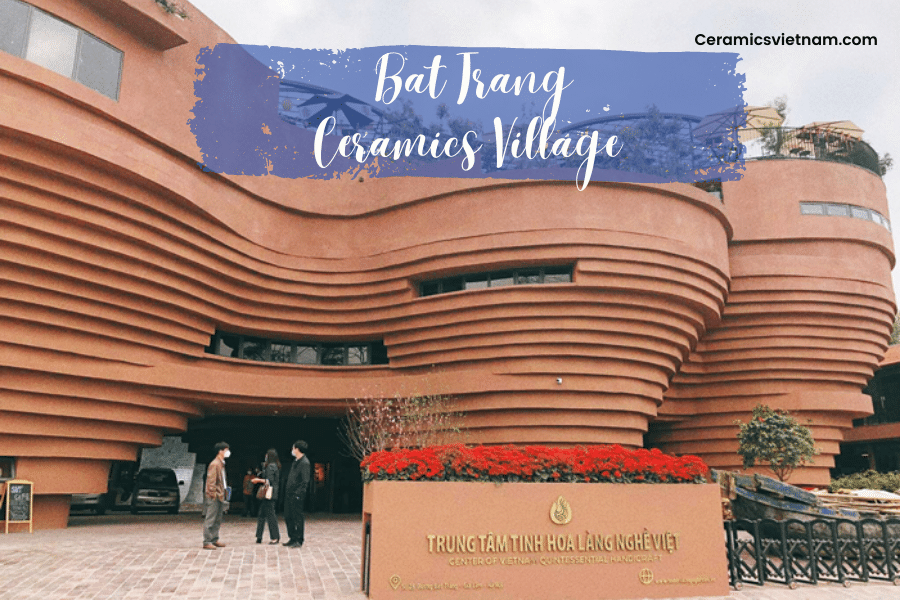
Touring Bat Trang is a unique and unforgettable experience
Shopping for Ceramics
Shopping for ceramics is one of the main attractions of Bat Trang, and visitors to the village will find a wide variety of ceramics for sale, ranging from traditional to modern designs.
Many of the ceramics workshops in Bat Trang have their own stores, where visitors can purchase directly from the artisans themselves. These stores offer a wide range of ceramics, from practical items like plates and bowls to decorative pieces like vases and figurines.
Visitors can also find ceramics in the local markets and stores, where they can haggle for the best prices and browse through a wider selection of goods. Many of the ceramics sold in these markets and stores are hand-painted and made using traditional techniques, ensuring that they are of the highest quality.
When shopping for ceramics in Bat Trang, it’s important to keep in mind that many items are fragile and should be packed carefully for transport. Many of the stores and workshops offer packaging services to ensure that your ceramics arrive home safely.
It’s also important to note that prices in Bat Trang can vary widely, depending on the quality and complexity of the ceramics. Visitors should be prepared to haggle and negotiate for the best prices, and they should also be aware that some items may be cheaper if purchased in bulk.
On the whole, shopping for ceramics in Bat Trang is a unique and rewarding experience that offers a chance to bring home a piece of Vietnam’s rich cultural heritage. Visitors can find beautiful and high-quality ceramics at reasonable prices and support local artisans who have been creating these works of art for centuries.
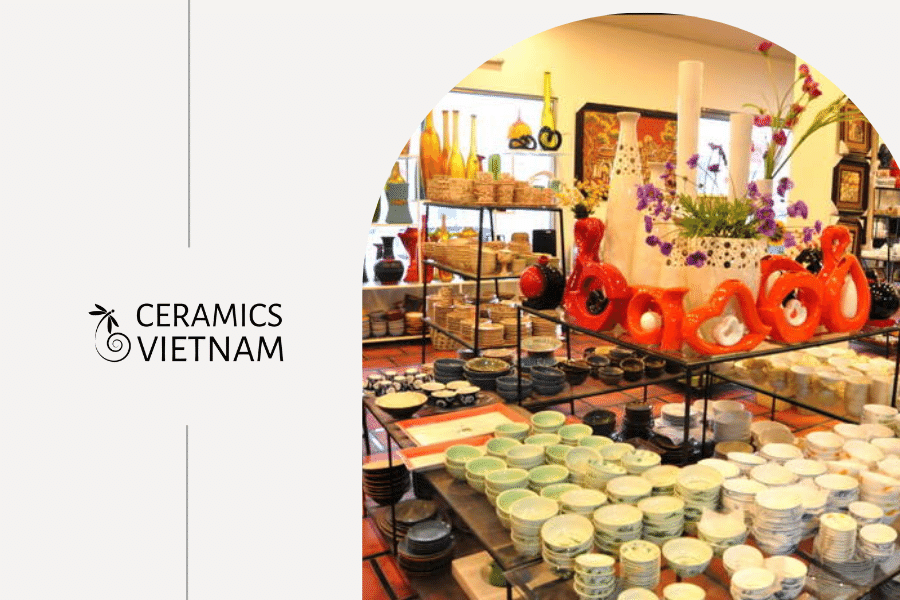
Shopping for ceramics in Bat Trang offers a chance to bring home a piece of Vietnam’s rich cultural heritage
Tips for Hanoi City Tour with Vietnam Bat Trang Ceramics Village
Here are some tips to make the most of your Hanoi city tour with Vietnam Bat Trang Ceramics Village:
Dress Appropriately
When embarking on the Hanoi city tour with Vietnam Bat Trang Ceramics Village, it is important to dress appropriately and respectfully when visiting temples and mausoleums. These religious and historic sites hold great significance in Vietnam’s culture and history, so it is important to show respect by dressing modestly.
When selecting clothing for the tour, visitors should ensure that their shoulders and knees are covered. Clothing that is revealing or provocative, such as shorts or tank tops, should be avoided. Clothing made from light, breathable fabrics is recommended, as the weather can be hot and humid.
In addition to dressing modestly, visitors should also wear comfortable shoes. The tour involves a lot of walking, so comfortable footwear that can withstand the amount of walking involved is essential. It is also a good idea to bring a hat and sunglasses to protect oneself from the sun.
By dressing appropriately, visitors demonstrate respect for Vietnam’s culture and history while enjoying their tour experience to the fullest. It is an opportunity to immerse oneself in the local culture and traditions, while also exploring the city’s beauty and history. Therefore, it is recommended to dress comfortably and appropriately for the tour and enjoy the rich culture and history of Hanoi.
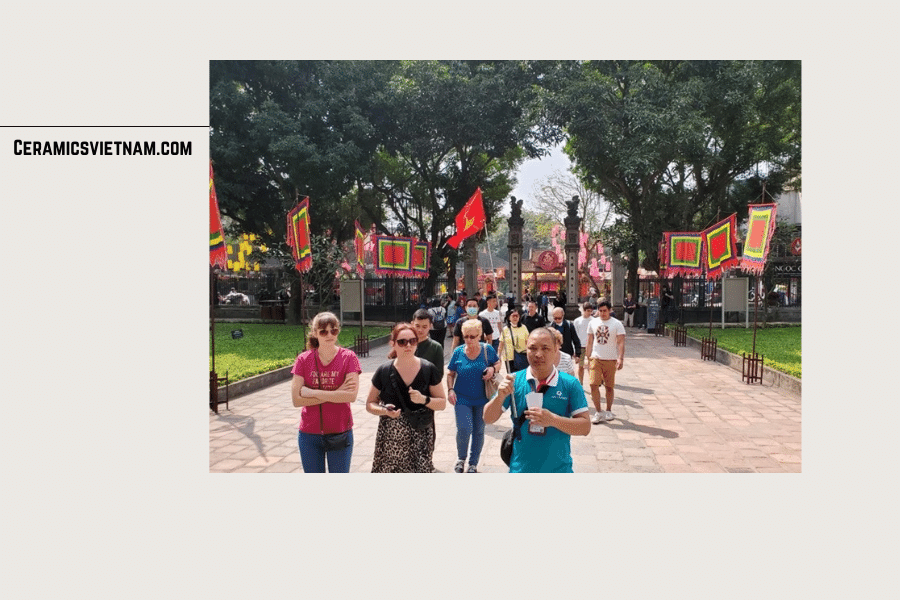
Visitors show respect for the culture and history of Vietnam by dressing appropriately
Bring Cash
When visiting the local market on the Hanoi city tour with Vietnam Bat Trang Ceramics Village, it’s important to bring cash with you. While some vendors may accept credit or debit cards, it’s more common for them to accept cash only. Therefore, it’s best to be prepared and bring enough cash with you to avoid any inconvenience.
In addition to bringing cash, it’s also recommended to bring small bills, as vendors may not always have change for larger bills. It’s also a good idea to keep your cash in a secure location, such as a wallet or a zippered pouch.
If you find that you need more cash during the tour, there are several options for exchanging money. The local market is a common place for exchanging money, and there are also local banks and exchange bureaus in Hanoi where you can exchange currency.
It’s important to note that exchange rates may vary, so it’s advisable to research the current rates before exchanging money. Additionally, it’s always a good idea to keep an eye on your belongings and be aware of your surroundings when exchanging money in public places.
By bringing enough cash with you and being aware of the available options for exchanging money, you can ensure a hassle-free experience on the tour. This way, you can focus on enjoying the local market and all that it has to offer, without having to worry about running out of cash.
Try the Street Food
When exploring the Old Quarter on the Hanoi city tour with Vietnam Bat Trang Ceramics Village, visitors should not miss out on the opportunity to try the city’s famous street food. Hanoi is renowned for its culinary scene, and the Old Quarter is the best place to experience it firsthand.
One of the must-try dishes in Hanoi is pho, a delicious and hearty noodle soup made with slow-cooked beef bones, rice noodles, fresh herbs, and lime. Hanoi is home to some of the best pho stalls in Vietnam, and trying this iconic dish is an essential part of any Hanoi food adventure.
Another popular street food in Hanoi is banh mi, a delicious French-inspired sandwich that combines a crispy baguette with a range of fillings, including pork, pate, cucumber, and pickled vegetables. It’s a perfect example of the fusion of French and Vietnamese cuisine.
Bun cha is another Hanoi specialty that should not be missed. It features grilled pork, vermicelli noodles, fresh herbs, and a sweet and savory dipping sauce, making it a favorite among locals and visitors alike.
Sampling Hanoi’s street food is a fantastic way to immerse oneself in the city’s culinary culture, and the Old Quarter is the perfect place to experience it. Visitors to the Hanoi city tour with Vietnam Bat Trang Ceramics Village can explore the bustling streets and alleys, trying the local delicacies as they go. It’s an opportunity to engage with the city’s vibrant culture while also indulging in the unique flavors and aromas of Hanoi’s street food scene.
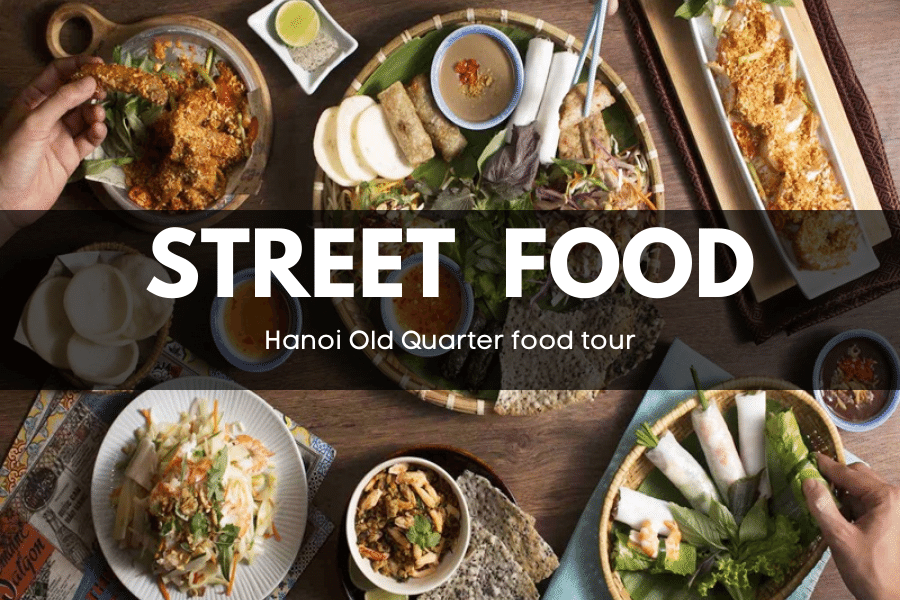
The street food in Hanoi is a significant part of the city’s culinary culture
Bring a Camera
The Hanoi city tour with Vietnam Bat Trang Ceramics Village is a fantastic opportunity to explore the culture and history of the city and capture some great photos along the way. The tour takes visitors to many famous and historic landmarks, offering countless opportunities to take memorable photos.
It’s highly recommended to bring a camera or smartphone to capture these special moments. Whether it’s a beautiful landscape or a unique cultural experience, the tour provides plenty of opportunities for great photos. Make sure to charge your camera or smartphone before the tour and bring extra batteries or a power bank, so you don’t miss any photo opportunities.
While taking photos, it’s essential to be respectful and follow the guidelines of each site. Some locations may prohibit photography, while others may require visitors to turn off their flash. It’s always a good idea to ask for permission before taking photos of people, especially in sensitive or private areas.
Capturing memories through photography is a great way to document your experience and share it with others. It allows you to relive the moments and emotions of the tour, long after it’s over. So, make sure to bring your camera or smartphone on the Hanoi city tour with Vietnam Bat Trang Ceramics Village, and take advantage of the many opportunities for great photos.
Conclusion
In conclusion, the Hanoi City Tour with Vietnam Bat Trang Ceramics Village is a wonderful opportunity to explore the history and culture of Hanoi. With visits to iconic landmarks, the bustling Old Quarter, and a traditional ceramics village, visitors can experience the very best that Hanoi has to offer. With a flexible cancellation policy, affordable pricing, and accessibility for all visitors, this tour is an excellent choice for those looking to explore the city in depth. By booking the Hanoi City Tour with Vietnam Bat Trang Ceramics Village, visitors can create memories that will last a lifetime.
FAQs
- What is the best time to visit Hanoi and Bat Trang?
The best time to visit Hanoi is from September to November or from March to April, when the weather is mild and dry. Bat Trang can be visited year-round. However, it is best to avoid the rainy season from June to August.
- How far is Bat Trang from Hanoi city center?
Bat Trang is located about 13 km from Hanoi city center. It takes around 30 minutes to adventure the journey by car.
- Are there any hands-on pottery-making experiences available in Bat Trang?
Yes, many of the workshops in Bat Trang offer hands-on pottery-making experiences. They allow visitors to create their own unique pieces.
- Can I bargain when shopping for ceramics in Bat Trang?
Yes, you can freely bargain. Visitors should be prepared to negotiate the price to get the best deal.
- Is it safe to travel to Hanoi and Bat Trang?
Yes, Hanoi and Bat Trang are generally safe for travelers. However, visitors should take normal precautions to avoid theft and scams, especially in crowded tourist areas.














Leave a reply